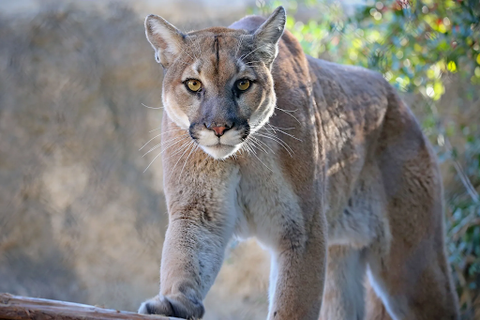Your Cart is Empty
Puma concolor cougar belongs to the family Felidae. Cougar is the large cat called mountain lion, catamount, painter, puma, catamount, and panther.

Cougar is the second largest cat around the New World and the fourth-largest cat all around the World. Cougar is a crepuscular and nocturnal mammal.
The color of a cougar may sometimes vary, and sometimes even siblings have different colors. Cougar has one color. It may be silvery-grey with light brown spots on other body parts such as the throat, under body, jaws.

Cougar body color varies with the growth like the infants are brown and spotted.

Males are larger as compared to females. Males range in size from 7 ft 11 in from nose to tail while females are 6 ft 10 in.
In terms of body weight, males are heavier than females. The average body weight of females is 30 to 64 kg while males are 54 to 100 kg.
The ears are erect. They can hear sounds from all directions as they have a good sense of hearing.

The eyes of a cougar are well adapted to see in the dark, have a good vision, and see their prey from a distance. Cougars have greenish golden eye shine, while kittens have bright blue eyes.

Cougar has an excellent leaping ability due to its long and more muscular hind legs; it can leap from ground to 18ft height. It has powerful paws and strong claws adapted for clutching the prey.

Cougars have carnassial, canine, incisors adapted for shearing, puncturing, and chewing, respectively.

Cougars are agile and muscular and can run at 64 – 80 km/h.
Cougars in wild environments can live up to 13 years, and in captivity, they can live up to 21 years.
Cougars are present in forests, open lands, deserts, lowlands, escarpments, rim rocks, steep canyons. They have the widest range of all wild animals. Cougars are terrestrial animals.

They are present in South America, Canada, eastern North America.
Cougar pursues a large range of prey as the cougar is an ambush predator. Even the small ones also start to make their kills at only six months; they eat rabbits, birds, squirrels.

Cougar’s claws are modified for clutching the prey. Cougar is carnivorous, and its diet may include,
Females are sexually mature at the age of about three years. The gestation period is 91 days. About two to six cubs are produced; the kittens are blind at first and dependent on their mother. Females build the territories.
Female puma and male leopard mate (vice versa) produce a hybrid pumapard. The hybrid pumapard inherits half of the size of the parents. The hybrid has a long body and short limbs; the coat is grayish brown.

Challenging and the most difficult is cougar hunting. Cougar is a big game animal. You must take into account some crucial tips as,
Comments will be approved before showing up.
